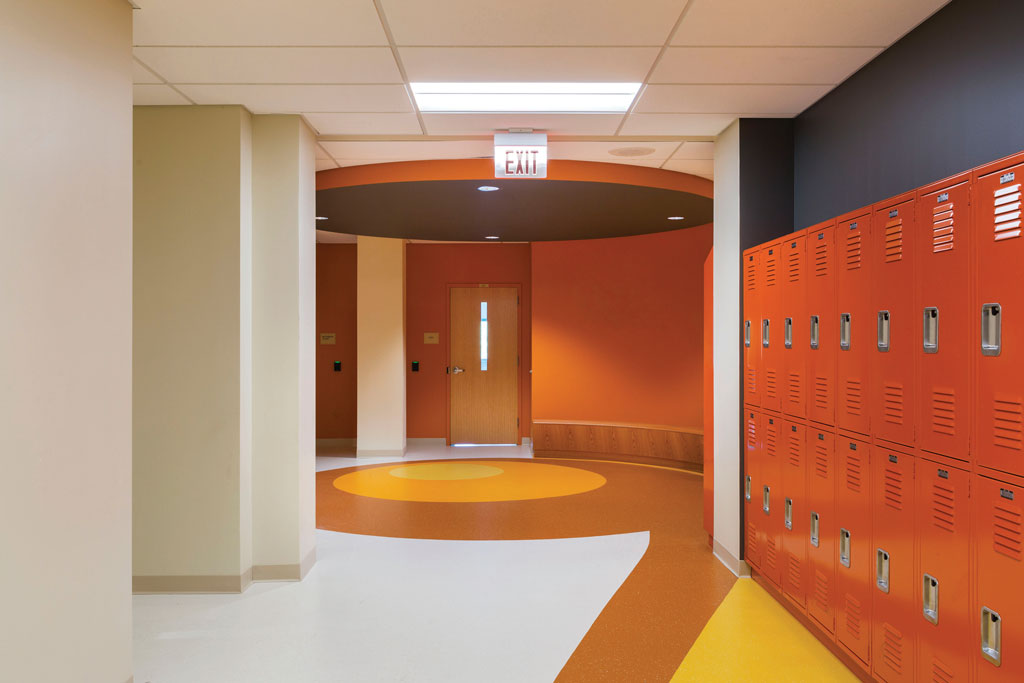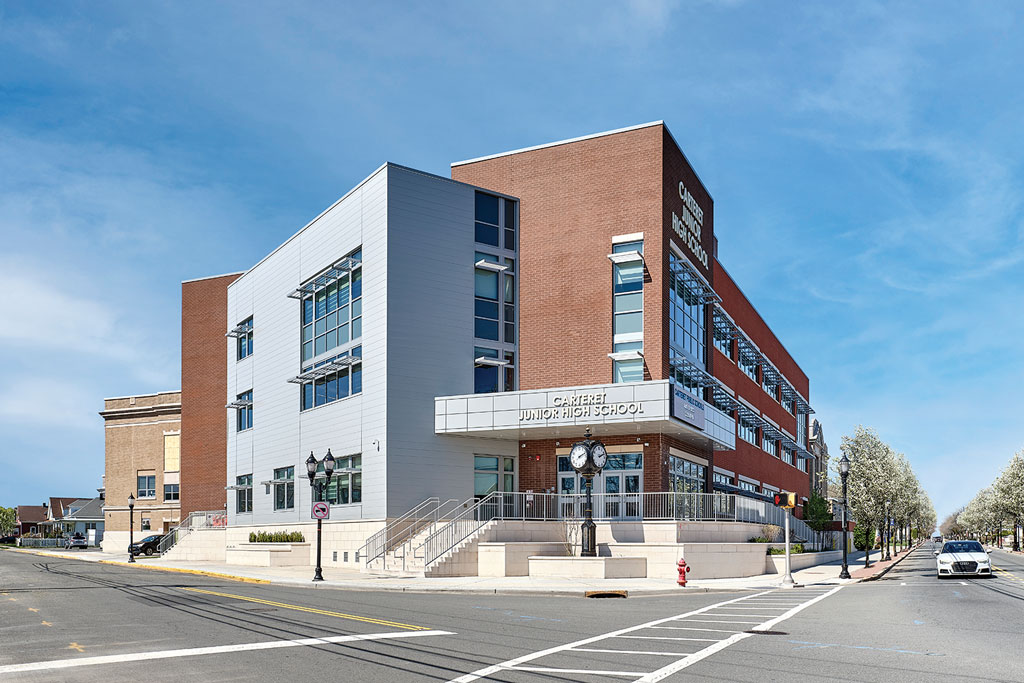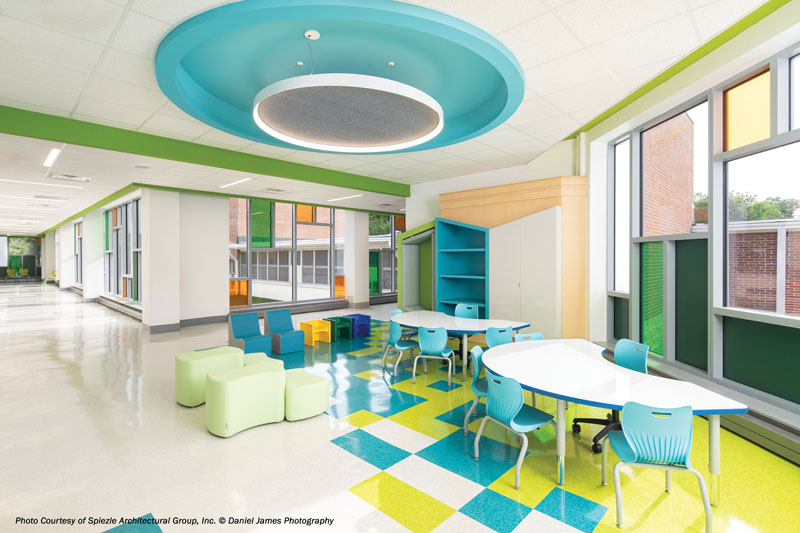When a school district is navigating a big construction project, it must focus on the budget, the timeline and keeping the public informed.
What sometimes gets lost is this: School design has a huge impact on the performance of students – as well as teachers.
Kurt Vierheilig, a partner and the director of design at DMR Architects, keeps the overarching goal of designing buildings where students and teachers can succeed top of mind at all times.
How school design interfaces with student achievement is “so important that maybe people don’t talk about it enough,” he said. “Everyone is concerned with how much a building costs … just being able to deliver a school to ease capacity issues and get students into proper classrooms has become a huge focus.”
Getting as much right as possible during the design process is key when it comes to improving learning and academic achievement, Vierheilig said. “Good architects and good designers who understand the K-12 environment know how little things can make a big difference,” he said.

The Importance of Light When thinking about student achievement, let there be light – and preferably natural light, Vierheilig said, noting that studies have shown our minds and bodies react to it better than the artificial variety.
“We make a concerted effort to maximize the number of windows,” he said, noting that if it’s possible, larger windows or a ribbon of windows are preferable than smaller windows.
Scott Downie, principal of Spiezle Architectural Group, also cited studies that link increased natural light to improved attention spans, better overall health and feelings of comfort – as well as improvements in academic performance.
“Such studies have found similar benefits from natural light across other building types, so it’s not just students that benefit, but teachers, and other users of school buildings as well,” he said. “Natural light in particular is a critical component of school designs, including using internal glass to transfer natural light into interior spaces … Daylight harvesting systems and proper interior lighting can help maintain even lighting levels in a classroom during the day while saving energy, as these systems automatically turn on/off lighting near windows depending on the brightness of conditions outside.”
Careful planning of interior lighting layouts and well-designed window views improve the classroom learning environment and increase academic achievement, Brett B. Daniels, an engineer and account executive at McClure Company said.
“During the lighting system upgrade conducted at the Butler Public Schools, Aaron Decker Elementary School, multipurpose room, our team focused on using the natural light from the building design to improve the health of the space and save energy,” he said. “By incorporating high efficiency LED technology with daylight sensing control technology, we were able to reduce power consumption and improve the learning environment of the multipurpose room space.”
He noted that lighting professionals understand that illuminance depends on the type of task a student is undertaking. For instance, if a student is threading a needle, they’d need more light. If they’re reading on a computer screen, they require less task lighting. “Students feel more comfortable, are better focused and exhibit a confident attitude toward performing the task with the correct amount of light,” Daniels said.
Natural light, which can change the entire mood of a space, is particularly important, Vierheilig said. There have been multiple occasions where his firm has received compliments from observers who thought a room was larger than it was simply because of the number and size of the windows incorporated in the design.
But incorporating natural light can be challenging given that there is usually a premium on wall space. “You are competing with presentation space, cabinets and bookshelves,” he said.
Also, if you’re working with an existing, older building, natural light may not always be readily available, Downie noted. “In these cases, designing with the right types of artificial light can attempt to replicate some of these benefits,” he said. “LED lighting can be tailored with warmer temperatures (2,500-3,000 Kelvin) for reading or relaxing and cooler (4,900-6,500 K) for work and attention/focus. In such situations, LED lighting upgrades can be huge energy savers and incentives from public utilities are still available.” He added, “In short, it’s almost never an either or, but designing both existing buildings and new buildings to maximize and manage daylighting, while properly designing artificial light, to achieve the overall best results should be the goal for any school project or upgrade.”
With students so often learning on computers instead of with pencil and paper, light has taken on an even greater importance in enhancing student achievement, as glare can be a hindrance.
“With every student having a laptop and focusing on a screen, the reduction of eye strain helps maintain a student’s focus on whatever task is at hand,” Vierheilig said.
George R. Duthie, principal of FVHD Architects-Planners in Ewing, New Jersey noted that while natural light is important, too much light can be a problem. “Sometimes, it is appropriate to utilize diffusion or even room-darkening shades,” he said. “Both window glazing and window shade systems offer numerous options for light control.” He added, “Artificial lighting should be properly designed to allow for varying lighting levels dependent upon activities in the room. Modern LED fixtures offer a high degree of adjustability. Changing the ‘color temperature’ of the lighting (i.e.- warm white, soft white, daylight) may be desirable in certain settings.”
Occupants can maintain a high level of control over the room lighting with wireless controllers., Duthie said. “Many of these can be programmed for customized lighting scenarios to suit whatever is going on in the room at that time,” he said.

Acoustics Another key factor where design and construction can pay big dividends in student achievement is ensuring classrooms have good acoustics, Vierheilig said.
“You want to look at ceiling systems that will help mitigate and absorb sound,” he said. “In areas where you can have tackboard art displays where you can afford the space to have acoustical absorption, take advantage of that. Students react to background and ancillary noise.”
Take steps to eliminate sounds that can travel between classrooms, he said. “Provide walls that eliminate the transmission of sound between them,” he said.
Making sure everything is constructed to your specifications is key, Vierheilig said, observing that it could be the best design in the world, but if the construction is shoddy, student achievement will suffer.
Everything, for instance, needs to be caulked and sealed – even electrical outlets. “Noise will travel through anything that is not sealed,” he said.
Keeping tabs on construction is important, Vierheilig said.
“A good set of documents is the best way to start,” he said. “And we address those items, whatever it is. For ductwork, you specify that the joints get sealed up. Specifying is the first thing. Next, you identify what materials they will be using.” He added, “You need a good construction administrative team, and at DMR, we do construction oversight of all our projects and make multiple visits per month … you need to make sure the things that are expected are happening.”
Within buildings, different spaces need to be designed with different acoustic performance, appropriate to their use. “Acoustic performance impacts speech intelligibility and the ability to learn and understand as a result,” Downie said. “Music rooms are designed to perform differently than classrooms. Guidance and nursing areas must provide high levels of acoustic privacy, and building envelopes must be designed to consider the noise outside the windows, for example.”
The U.S. Green Building Council includes requirements related to sound transmission and background noise in its LEED green building standards as do the International Building Code, WELL building, and other standards, Downie pointed out. “Floor finishes, wall finishes, ceilings, insulation within walls, insulated ductwork and other mechanical system features, types of floor and roof structures, even the placement of landscaping outside the building can impact noise within spaces and how sound is perceived,” he said. “Districts and their design teams should discuss the types of activities that will occur in spaces early in the process, so designs can target the right sound performance qualities for each space.”
While you want to mitigate and keep out sounds in some places, in others – such as classrooms – you may want to consider enhancement systems that can pick up and amplify voices to improve students’ ability to hear and understand speakers within spaces, Downie said. They can be cost effective and are commonly used.
“Mechanical systems, which now move more air at higher velocities than in the past, can impact space acoustics significantly,” he said. “Many spaces, particularly larger and assembly-oriented spaces, lend themselves to low velocity air delivery systems. Rather than pushing air down at high velocity from the ceiling, these designs introduce air at lower velocity near the floor, using natural air flow dynamics to flow the air up versus down and exhaust it higher near the ceiling. The required ventilation is delivered with far less velocity and noise.”
When classroom vertical unit ventilator systems are used, they can and should be equipped with acoustic “packages” when they are specified – and ducted designs tend to be quieter than non-ducted designs for these units, Downie said. “Furniture can play a role in classroom acoustic performance as well – movable seating enables rooms to be quickly reconfigured,” he said. “Students can gather closer in one area for group chats and spread out for quieter, individual work. Fixed or hard-to-move desks and tables keep people in the same position within a room regardless of whether group or individual work needs to happen. As a result, larger spread-out groups can have a harder time hearing a teacher and can’t gain separation that is beneficial for individual or small group work.”

Air Quality, Maintenance and ComfortDesign is paramount, construction is critical – but don’t forget about maintenance when it comes to putting students in a better position to succeed.
Air quality and making sure heating and air conditioning systems are properly maintained are certainly a contributing factor to promoting student achievement, Vierheilig said.
“Indoor air quality is probably the most complained about thing in schools,” he observed. “And that includes the temperature, the humidity … and the fresh air that is being provided to a space.”
The bottom line is whether you are hot or cold, you’ll be uncomfortable, and you won’t be able to focus on learning. Moreover, teachers won’t perform as well, either.
Issues with temperature can also cause more sinister problems, such as mold growth, which can shut down a school altogether, really putting students behind.
“Comfort is critical for success,” Downie agreed. “Numerous studies have connected comfort, proper ventilation and temperature, along with other features like daylighting, to positive learning outcomes and physical comfort, which also benefits teachers. While everyone has different ideas of what a comfortable temperature is, spaces should have some controllability and designs should consider how air is delivered to avoid hot/cold spots or blowing high velocity air on areas of a space, which can result in discomfort.”
Poor indoor air quality in schools influences the performance and attendance of students, primarily through health effects from indoor pollutants, Daniels said.
“In 2021 during a boiler plant upgrade, we replaced the complete heating and cooling system at the Teaneck Public Schools, Teaneck High School,” Daniels said. “Our priority was to improve the entire health of the building and classroom learning environment by replacing the boilers, chillers and unit ventilators throughout the building. The improved efficiency of the units allows better control of temperatures, better filtration and air circulation, better humidity response and a fresh healthy atmosphere for learning.”
You want to design systems that bring in ample fresh air, Vierheilig emphasized.
“Fresh air is basically bringing in air to take out the exhausted, used air,” Vierheilig said. “Imagine you are in a room without fresh air recirculating, and it is the same air everyone has been breathing. You start to feel sluggish, tired and less focused. A good building design provides for air turnover, which keeps you more engaged and alert.” He added, “If you are in a room with someone who is sick and you are taking that air out, there is less of a chance that others will get sick.”
All of this applies not just to students but to teachers, too: If they are healthy, comfortable and feeling refreshed, they’ll be in school more often and perform better in the classroom, Vierheilig said. “What is good for one is good for the other,” he said.
Along those lines, just as space for learners is now being designed differently, architects and engineers are thinking about space for teachers as well, Downie said. “True professional collaboration areas are being created that help foster teacher-teacher interaction and peer support as well as providing the ability for teachers to create comfortable spaces of their own separate from the classroom,” he said. “Teachers are professionals, and good school design can consider their comfort right along with that of students and others.”
Sometimes, the connection between efficient heating and ventilation systems and student achievement is indirect. For instance, not many people may think about the fact that if an efficient system is running 30% of the day instead of an inefficient system that needs to run half the day, you’re saving money that can be spent on other programs and initiatives.
Since the eruption of the COVID-19 pandemic, mechanical systems have been designed to deliver higher air volumes and increased levels of fresh air to spaces to improve air quality, Downie said. “In some cases, existing systems can be adapted with higher filtration levels to improve air quality, but districts should be careful since fitting units with higher level filters than they are designed to handle could reduce air flow and be counterproductive,” he cautioned. “Higher velocity air means more potential for air noise, particularly with systems not originally designed for those higher velocities.”
Ideally, ductwork in mechanical systems should be insulated and sealed properly, so the right volumes of air are delivered to the intended places, Downie said. “Upgrading existing ductwork may be a cost-effective alternative to replacement, depending on configuration, and rebalancing the air flow across HVAC systems can often improve the results delivered by existing systems,” he said. “It is also important for districts to be clear about the activities and programming that will occur in spaces as well as their goals when approaching HVAC designs with their professionals. For example, the range of activity sound levels from quiet to loud in a space needs to be considered when system types, ductwork layouts, and other factors are considered in design. If the goal is reduced operating costs, high efficiency units will operate with greater efficiency than older units, but they will also be working harder to deliver the higher volumes of air and fresh air required by current codes so ‘higher efficiency’ units don’t always result in lower energy costs.”
“The importance of appropriate ventilation and temperature control cannot be overstated,” Duthie said. “Modern classroom HVAC systems are energy efficient but also provide proper air distribution, enhanced filtration, and accurate temperature and humidity control.”
Additional Factors Architects and engineers don’t just think about the physical construction of the building; they also think about the furniture, desks and more.
“The Department of Education actually reviews that to confirm it is in compliance with educational specifications,” Vierheilig said. “As the architect, we lay out every desk, every cabinet and every learning zone depending on the type of classroom.”
For instance, if it were a preK classroom, the space would be designed with a play zone and learning zone. A high school classroom would look much different.
On the subject of zones, Duthie noted that “quiet zones” in classrooms as well as separate “sensory” rooms can provide a quiet place where students experiencing physical or emotional overload can relax and regain their composure. “These are typically equipped with soft surfaces, specialty seating, and restful lighting to foster peace and tranquility (and reduce any chance of injury),” he said.
Even color can play a role in keeping students engaged and alert, Vierheilig observed. “In general, we try to incorporate bolder, stimulating colors, but they can’t be obnoxious,” he said. “Using stimulating colors appropriate in a space can help your eye go from one surface to another.” He added, “A color-stimulating place as opposed to a gray, neutral space can make your mind work and think differently.”
Just like with the layout of desks and zones, colors may change based on the age of the students.
“A preK classroom may bring in more primary colors, colors that young students can relate to more – but in a high school environment, it might be more subdued, it might be softer.,” Vierheilig said. “You may want to use a color that moves them in a different direction because they are working their way to go to college or a different environment.”
How to incorporate furniture should be addressed early on in the design process, Downie said. “The design of an educational space and the furniture within it are interdependent and can’t be considered apart from one another without reducing the impact of each,” he said. “Most spaces today are designed to minimize fixed casework and installations while maximizing movable furnishings instead. This enables endlessly variable space and use throughout a school, so the students and teachers get to define how space is used to engage in learning over the course of a day.”
Examples include cubbies in early childhood spaces that can be mobile, allowing them to be moved to open up space for broader activity use; media centers with laptops instead of desktop computers, varied seating options, and mobile book shelving. Moreover, auditoriums can be designed to support broader activities, Downie said.
The sizes, various placements and configurations of furniture may be affected by factors such as room dimensions and proportions, barrier-free accessibility, safe egress and others, Duthie said. “Classroom furniture is subject to significant wear and tear. Therefore, it is important to select furniture that is durable, time proven and easily repaired,” he said. “Furniture that is ergonomic, soft seating, and rocking seats offer a break from the rigidness of standard desks and chairs. Even teacher desks are on the move – mobile tables with up and down adjustment allow teachers to go to the students.”
When choosing, consider classroom furniture that can be adjusted for height and positioned in various groupings – and don’t forget about storage, Duthie advised. “Classroom furniture must have easy-to-clean surfaces,” he said. “Lightweight furniture that can be easily reconfigured and nested or stacked will greatly increase flexibility.”
All of these things are important because “comfortable students learn better,” Downie said. Seats that allow small and larger students to be comfortable and that can be moved around quickly to accommodate individual and group activities make it easier for students to learn. “Without this adaptability, student, or teacher, comfort is compromised, and energy gets spent trying to adapt a lesson to a fixed and less than ideal space,” he said.
Collectively, a good design and construction should play a role in promoting mental health for both students and staff. “A guidance or health suite that is not comfortable for students to visit means those critical support services might not be used,” Downie pointed out. “Spaces that are too public, undersized, or not accessible when needed will not succeed. We typically design these spaces to incorporate levels of privacy as well as non-public waiting areas, a high sensitivity to acoustics and visual privacy, and often they are more distributed around a school building than in one central space next door to the principal’s office.”
School design has evolved a great deal even in the last decade, Duthie observed. “Much of this evolution has resulted from the drive toward improving student physical, mental and emotional well-being,” he said. “Ideally, the learning space will accomplish two primary goals: Prepare the students to learn and then facilitate the learning process. To this end, designers must work to create spaces that are secure, comfortable, flexible, functional and adaptable.”

A school designed with security in mind also contributes to creating a positive school environment and, in turn, more comfort and wellness, Downie said. How secure students feel at the front door as well as when participating in different activities is critical for success, he said.
Making sure design accounts for technology is also critical, Duthie said. “The role of technology cannot be overstated,” he said. “As technology can become quickly obsolete, it is best to provide infrastructure (conduits, boxes, cables and sleeves) that will allow for future advancements,” he said. “A modern learning space contains many technologies – safety, security, communications and of course, streaming and connectivity. Portability is key to functionality. Consider every place in a room where a portable device may be used. Today, many devices are completely wireless and the use of Power Over Ethernet devices has become commonplace.”
As an architect, it is always rewarding to know that the work on the design front has paid off in the classroom.
“Our impact stops when students enter the space and start learning, and the educators pick up from there,” Vierheilig said. “It is satisfying for us to know when we do things the right way and when we hear about the impact.”
Thomas A. Parmalee is NJSBA manager of communications and publications.



